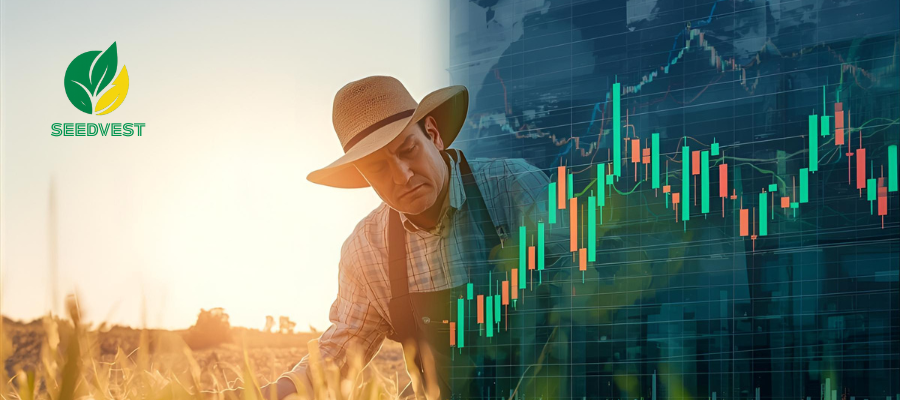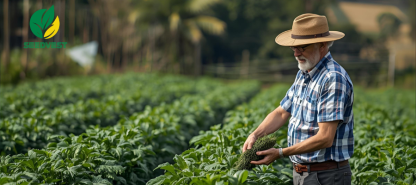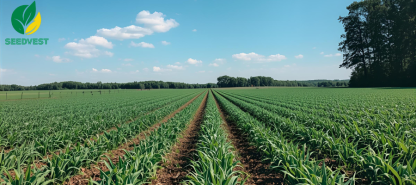
- 21 Oct 2025
Agriculture Investing vs Forex: Safer, More Profitable?
At Seedvest, we curate agricultural investment opportunities that balance growth with resilience. Our platform connects institutional and individual investors with farms, agribusinesses, and climate-smart ventures that leverage modern farming techniques, data analytics, and transparent governance. By combining rigorous due diligence with a focus on sustainable farming practices, we help investors access long-term cash flows tied to real assets rather than purely speculative instruments. This blog explores how agriculture investing compares to forex trading, and why many investors find agriculture to be a safer, increasingly profitable component of a diversified portfolio while aligning with global sustainability goals.
Forex markets offer high liquidity, 24/7 trading, and the potential for rapid gains through leverage. However, they also expose traders to significant volatility, leverage risk, and macro-driven swings that can wipe out short-term profits. Agriculture, by contrast, anchors value in tangible assets and real-world scarcity: arable land, crops in the ground, storage facilities, and processing capacity. While forex outcomes depend on interest rates, geopolitics, and currency flows, agricultural investments are influenced by weather, yields, demand for food, and supply chain efficiency. This does not make them risk-free, but it positions farming assets to behave more predictably over multi-year horizons, especially when diversified across geographies, crop types, and value-chain activities.
From a risk-management perspective, agriculture tends to offer built-in floors: physical assets with value regardless of short-term market sentiment, and revenue models that combine commodity sales, processing margins, and service contracts. Weather shocks or pests remain risks, but these can be mitigated with diversification, crop insurance, contract farming, and price hedging through futures and forward sales. Compared with forex, agricultural investments can benefit from longer investment horizons, compounding returns over seasons and years, and the potential to earn through multiple streams—premium yields, storage optimization, and value-added processing—rather than a single, continuous bet on currency movements.
Profitability in farming is driven by factors you can monitor and optimize: yield per acre, input costs, water and energy efficiency, and access to markets. Sustainable farming practices, such as soil health improvement, precision irrigation, and regenerative techniques, often reduce operating costs over time and open doors to incentive programs, carbon credits, and premium markets for sustainably produced goods. When investors participate through Seedvest, they gain exposure to diversified farm portfolios that balance risk and reward across crops, regions, and stages of the value chain. The result can be steadier cash flows, lower drawdowns during market downturns, and compounding growth that aligns with inflation and demographic demand for food.
Seedvest emphasizes sustainable farming because it strengthens resilience and long-term profitability. Climate-smart agriculture reduces water usage, lowers emissions per unit of output, and supports farmers in weather-stressed regions. These practices tend to improve yield stability, expand access to credit, and attract partnerships with buyers who prize consistent quality. For investors, this means not only clearer forward-looking returns but also alignment with environmental, social, and governance (ESG) criteria that many funds and institutions increasingly require. In short, sustainable farming is not a niche; it is a strategic driver of risk-adjusted returns in modern agriculture.
Investment opportunities on Seedvest span direct farm equity, specialty agribusiness, and infrastructure that enhances the efficiency of the food system. Investors can participate in scalable opportunities such as crop production with contract marketing, post-harvest storage and logistics, processing facilities, and agtech-enabled farming platforms. Each opportunity is accompanied by rigorous due diligence, clear governance structures, currency and market risk disclosures, and measurable sustainability metrics. By blending traditional farming assets with technology-enabled efficiency, Seedvest helps investors access diversified exposure that can withstand market volatility while contributing to global food security.
Education is a core pillar of prudent investment. Key metrics for agricultural ventures include cost of production per unit, break-even acreage, yield variance, disease and pest risk profiles, and the elasticity of demand. Investors should consider time horizons that match crop cycles, drought cycles, and policy cycles. Diversification across crop types, geographies, and value-chain activities helps dampen idiosyncratic shocks. Seedvest provides transparent performance data, scenario analyses, and governance reviews to support informed decisions and disciplined risk management, ensuring clients understand potential drawdowns as well as upside.
Practical steps to evaluate agricultural opportunities include performing site-level due diligence, assessing water rights and climate risk, reviewing off-take agreements, and understanding contract farming arrangements. Compare opportunities on liquidity, valuation discipline, and alignment with sustainable practices. Investors should also use hedging where appropriate, such as forward contracts, crop insurance, and diversified commodity exposures, to smooth revenue streams. Seedvest equips investors with research, due diligence checklists, and case studies to help you understand how a given investment interacts with weather, yields, price cycles, and currency exposure.
In conclusion, agriculture investing offers a compelling, potentially safer, and increasingly profitable alternative to forex for investors seeking real assets, inflation hedging, and sustainable growth. While forex may suit traders seeking high leverage and short-term opportunities, farming investments provide longer-term stability, diversified revenue, and a meaningful way to contribute to food security and environmental stewardship. Seedvest is committed to education, transparency, and governance that empower investors to make informed decisions. If you are exploring diversification, consider starting with a Seedvest-backed agricultural portfolio to learn, test assumptions, and build a resilient investment strategy for the years ahead.





